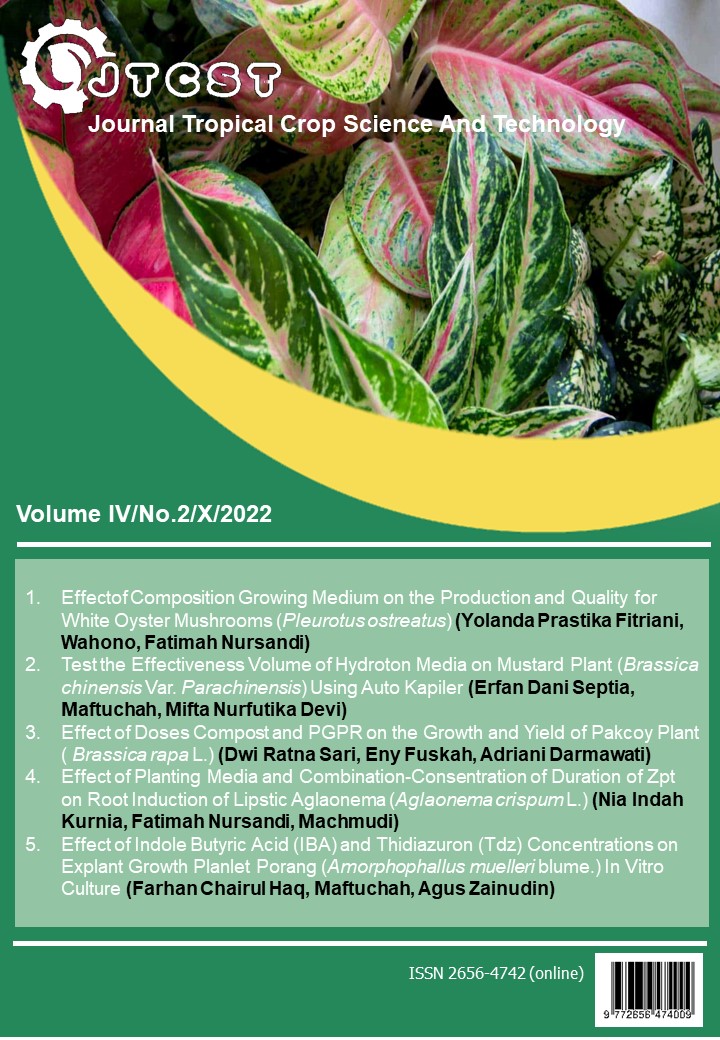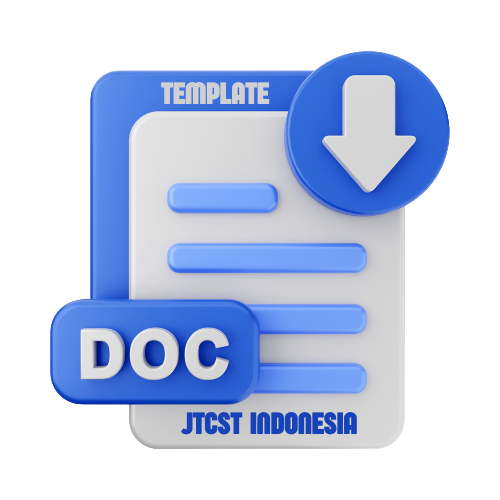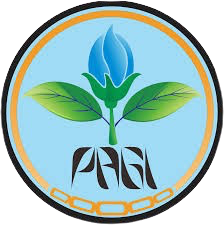Test the Effectiveness Volume of Hydroton Media on Mustard Plant (Brassica chinensis Var. Parachinensis) Using Auto Kapiler
DOI:
https://doi.org/10.22219/jtcst.v4i2.29731Keywords:
Oxygen, Nutrition, RootsAbstract
This study aims to determine the level of effectiveness the hydroton growing media on mustard plants using the Auto Kapiler hydroponic method with 3 treatments; M1 with hydroton growing media of 2,54 liters (volume 50%), M2 with hydroton growing media of 3,78 liters (75% volume), and M3 with hydroton growing media of 5,04 liters (100% volume). The research was conducted on Jl. Tirtonadi RT. 25 / RW. 04, Jatikerto village, Kromengan sub-district, Malang district which will take place from April 25 to June 14, 2022. Some of the materials and tools used during the research are; hydroton growing media, auto capillary, AB-Mix nutrition, pH meter, and EC meter. Variable observations made consist of; plant height (cm), number of leaves (strands), leaf width (cm), root length (cm), and plant fresh weight (grams). Data analysis in this study used a simple Completely Randomized Design (CRD) with 4 replications and 3 treatments. The data obtained were further analyzed using the least significant Least Significant Different (LSD) α 5% level which was then further analyzed using a linear regression. The results showed that the M3 treatment (100% hydroton growing media volume was 5,04 liters) was better than the M2 treatment (75% hydroton growing media volume 3,78 liters) and M1 (50% hydroton growing media volume 2,52 liter).
Downloads
References
Fauzi, R., Putra, E. T. S., dan Ambarwati, E. 2013. Pengayaan Oksigen di Zona Perakaran untuk Meningkatkan Pertumbuhan dan Hasil Selada (Lactuca sativa, L.) Secara Hidroponik. Jurnal Vegetalika. 2(4): 63–74.
Mariana M. 2002. Pengaruh Media Tanam Terhadap Pertumbuhan Stek Batang Nilam (Pogostemon cablin Benth). Africa Ekstensia, 11(1): 1-8.
Mubarok, Salimah, S., Farida, A., Rochayat, Y., dan Setiati, Y. 2012. Pengaruh Kombinasi Komposisi Media Tanam dan Konsentrasi Sitokinin terhadap Pertumbuhan Aglonema. Jurnal Hortikultura, 22(3): 251–257.
Pramanda T. 2019. Analisis Pertumbuhan Tanaman Kedelai (Glicyne soja) Terhadap Pemberian Urine Kambing dan Variasi Jarak Tanam. [Skripsi] Universitas Muhammadiyah Sumatera Utara. Tersedia di https://core.ac.uk/download/pdf/225825493.pdf [Diakses 3 Agustus 2022].
Pratiwi, P. R., Subandi, M., dan Mustari, E. 2015. Pengaruh Tingkat EC terhadap Pertumbuhan Tanaman Sawi (Brassica juncea, L.) pada Sistem Instalasi Aeroponik Vertikal. Jurnal Agro, 2(1): 50–55.
Sarido L dan Junia. 2017. Uji Pertumbuhan dan Hasil Tanaman Pakcoy (Brassica rapa L.) dengan Pemberian Pupuk Organik Cair pada Sistem Hidroponik. Jurnal AGRIFOR, XVI(1). ISSN P: 1412-6885. ISSN O: 2503-4960.
Subandi, M., Salam, N.P., dan Prasetya, B. 2015. Pengaruh Berbagai Nilai EC (Electrical Conductivity) terhadap Pertumbuhan dan Hasil Bayam (Amaranthus SP.) pada Hidroponik sistem Rakit Apung (Floating Hidroponics System). Jurnal UIN Sunan Gunung Jati, IX(2): 136–152.
Surtinah. 2016. Penambahan Oksigen pada Media Tanam Hidroponik Terhadap Pertumbuhan Pakcoy (Brassica rapa). Jurnal Bibiet 1 (1): 27-35. ISSN : 2502-0951.
Susnawati, L.D., dan Suharto, B. 2018. Kebutuhan Air Tanaman untuk Penjadwalan Irigasi pada Tanaman Jeruk Keprok 55 di Desa Selorejo menggunakan Cropwat 8.0. Jurnal Irigasi, 12(2): 109-118.
Wahyuningsih, A., Fajriani, S., & Aini, N. 2016. Komposisi Nutrisi dan Media Tanam Terhadap Pertumbuhan dan Hasil Tanaman Pakcoy (Brassica rapa L.) Sistem Hidroponik. Jurnal Produksi Tanaman, 4(8), 595–601.
Wisnuwati, dan Nugroho, C.P. 2018. Modul Pengembangan keprofesian Berkelanjutan: Biologi Bidang Keahlian Agribisnis dan Agroteknologi. Jakarta: Pusat Pengembangan dan Pemberdayaan Pendidik dan Tenaga Kependidikan Pertanian. 42 hal.
Downloads
Published
How to Cite
Issue
Section
License
Copyright (c) 2022 Erfan Dani Septia, Maftuchah, Mifta Nurfutika Devi

This work is licensed under a Creative Commons Attribution-ShareAlike 4.0 International License.
Authors who publish with this journal agree to the following terms:
- Authors retain copyright and grant the journal right of first publication with the work simultaneously licensed under a Creative Commons Attribution License that allows others to share the work with an acknowledgement of the work's authorship and initial publication in this journal.
- Authors are able to enter into separate, additional contractual arrangements for the non-exclusive distribution of the journal's published version of the work (e.g., post it to an institutional repository or publish it in a book), with an acknowledgement of its initial publication in this journal.
- Authors are permitted and encouraged to post their work online (e.g., in institutional repositories or on their website) prior to and during the submission process, as it can lead to productive exchanges, as well as earlier and greater citation of published work (See The Effect of Open Access).











